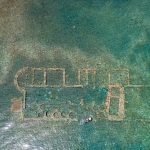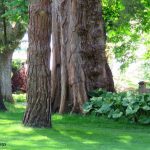Recently, while researching examples of flood geology, I heard about a particular fossilized tree in northern TN. After several weeks of trying to track it down, I was finally able to visit the site. The side of a mountain had been blasted away to uncover a coal seam, and what was discovered there was a very well preserved fossilized lycopod tree. This specimen was so pristine that in the 1970s, one issue of National Geographic featured photos of the tree in an article.
After travelling up to the area on a rainy day, the remoteness of the location was apparent from the lack of civilization as we got closer to the site. Ruins of the old coal mining operation could be seen scattered along the hillside. A rough ride in a 4 wheel drive up to the end of the road, and then a long hike over streams and through brambles brought us to the site.
Upright, Polystrat Tree Trunks
There, perfectly preserved, was the massive fossil, and with it, many other fossilized examples of these trees.
Although similar to the modern horse-tail, these lycopod specimens are much larger than anything that currently exists.
But there are a few things that make these very significant. Besides the excellent preservation, even down to the texture of the leaflet pods along the trunk, the first thing that stands out is the fact that these trees are fossilized in the UPRIGHT position! The second and most significant feature is the fact that these trees can be seen extending through multiple layers of strata!
If a secular geologist saw the same layers of strata anywhere else, they would conclude that each layer was laid down slowly over time, taking several million years for what we see here to be laid down through gradual deposition, then lithified, or turned to stone.
But wait! How could a tree remain upright for millions of years while sediment slowly builds up around the trunk, preserving it from decay?
There is only one way to explain what is seen at this site and other similar sites all around the world… Catastrophism.
Even most atheistic geologists will admit that this has to be the case. A tree simply CANNOT stand upright for the amount of time suggested by evolutionary timeframes.
There was a catastrophic event that we read about in the Biblical record which would account for precisely what we find here in northern Tennessee. The great flood in Noah’s day that would have uprooted vegetation, reshaped the continents, and buried a vast number of animals and plants extremely quickly underneath thousands of layers of sediment.
In some cases, root structure can be found, like this stigmaria (or root segment) I’m holding, while in other specimens, it appears as if the trees may have simply been snapped off by force, again, fitting with the account of the fierce global deluge described in the book of Genesis.
I’m David Rives…
Truly, The Heavens Declare the Glory of God.
LIKE David’s FB page here: http://www.facebook.com/DavidRivesMinistries
FOLLOW us on Twitter: http://twitter.com/TheDavidRives
VISIT our official website for tons of free information: http://www.davidrivesministries.org
David Rives MUSIC: http://www.davidrivesmusic.com
For the TBN show “Creation in the 21st Century”: http://www.creationinthe21stcentury.com







Hello David,
Just found your brilliant image of the polystrate fossil in northern Tennessee, and was wondering if you could send me a high res copy for use in a poster set I’m putting together for a high school science class. I may end up publishing the resource commercially at some stage, but will of course give full credit where it is due. The current project is on coal mining, but I also have a resource on fossils and dinosaurs that would greatly benefit from such an image.
Looking forward to your reply.
Thanks and God bless,
Peter
PS please check our website to see what we’re about – definitely on the creation side of science!
Who said the sediment builds up “slowly” in all cases? That is NOT what geologists believe.
And, if there was a catastrophe, why would there not be a single and very thick layer as opposed to the numerous layers seen in this picture?